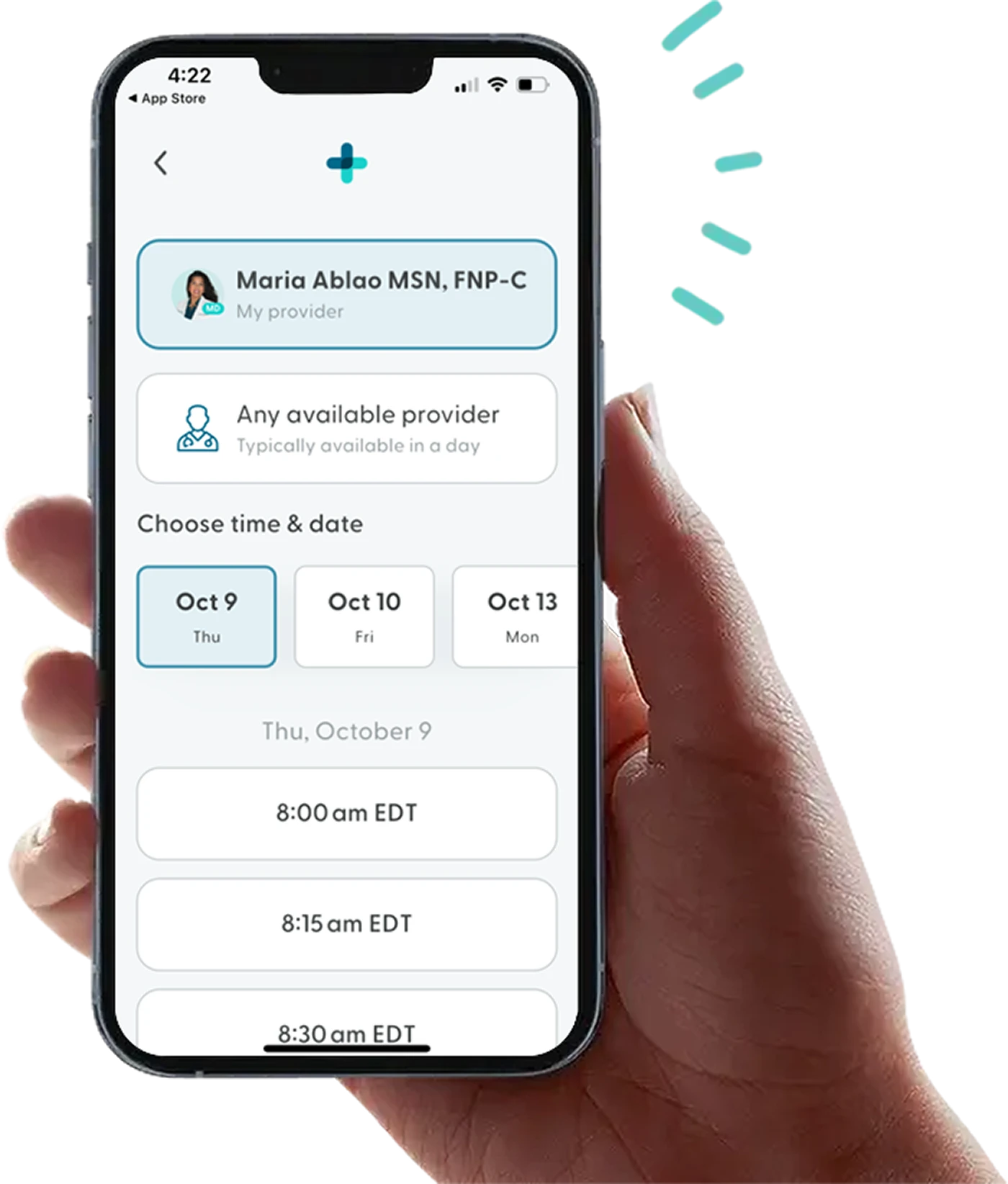Strategies for Preventing Postmenopausal Osteoporosis
As women approach menopause, they undergo a significant hormonal transition that can impact various aspects of their health — especially bone mass, density, and strength.
When bone health starts to decline during menopause, women are more prone to fractures and developing serious conditions like osteoporosis.
While menopause and declining bone health are largely inevitable, there are certain things you can do to minimize the risks posed by osteoporosis.
Feel like yourself again
A licensed provider can help you understand your symptoms and determine if hormone replacement therapy is the right next step.


Understanding Bone Health and Menopause
Bone health is a vital aspect of our overall well-being, as good, strong bones provide support, protection, and mobility.
Maintaining good bone health is essential for preventing conditions like osteoporosis, where the joints may become fragile and more susceptible to fractures.
Although this may seem straightforward, certain biological processes can have a big impact on your bone health.
For women, menopause – a period of significant hormonal changes in the body – has the greatest impact on bone health.
During menopause, hormones like estrogen decline rapidly. Estrogen plays a crucial role in maintaining bone density and strong muscle tissue.
When estrogen levels decrease, bone health is put at risk, and there is a bigger chance of developing conditions like osteoporosis.
This increased risk is usually most noticeable during the first few years of menopause when the hormone changes are most dramatic.
Key Point: Why Does Estrogen Decline During Menopause?
The rapid decline in estrogen is primarily due to changes in ovary function. These are the main reproductive organs responsible for producing hormones in women.
As women age, their ovaries get older, too, and the number of follicles inside them starts to decrease. With fewer follicles, the ovaries produce lower levels of hormones like estrogen.
The Importance of Calcium and Vitamin D
Calcium, minerals, and vitamins like vitamin D are two fundamental building blocks for maintaining strong, healthy bones. These supplements enhance bone formation which may help prevent fractures.
The bones get their strength and structure from protein, collagen, and minerals, while vitamin D and vitamin K are responsible for helping the body absorb this mineral.
We all need calcium and other minerals throughout our lives, but it becomes even more important during menopause when bone density starts to decline.
Focusing on getting enough of these nutrients can help you avoid brittle bones that can contribute to conditions like osteoporosis.
Where do you get calcium and vitamin D from?
There are a few ways to ensure you have enough calcium and vitamin D in the body. You primarily absorb calcium through your diet, which should include:
Dairy products like milk, cheese, and yogurt, for those who tolerate dairy
Leafy greens like broccoli, kale, and bok choy
Fortified foods like tofu and orange juice
For calcium to be used efficiently, it’s important to maintain sufficient vitamin D levels. Vitamin D helps the body absorb calcium from the digestive tract to promote bone health.
Besides dietary sources — like fatty fish, egg yolks, and fortified foods — one of the best sources of vitamin D is sunlight.
Spending time outside in the sun prompts the skin to produce vitamin D naturally, which helps you maintain adequate levels of this nutrient.
People with extreme vitamin D or calcium deficiencies may benefit from taking supplements.
Always speak to your doctor before taking these to determine if supplements would actually be helpful in boosting your nutrient levels.
How much calcium and vitamin D is recommended for postmenopausal women?
The recommended daily intake for calcium is around 1,000-1,200 milligrams, depending on your age.
You should also aim for between 600 and 800 international units (IU) of vitamin D every day.
Remember that these are not definite amounts, and some adjustments may be necessary, depending on individual factors.
Speak to your doctor or a licensed nutritionist to help you determine the correct amounts of vitamin D and calcium you’ll need to maintain your bone health.
Prioritizing Nutrition for Optimal Bone Health
Nutrition plays another important role in maintaining strong joints. Besides vitamin D and calcium, there are several other essential nutrients that can help promote bone health.
These nutrients include:
Magnesium aids in bone mineralization and supports the body in absorbing vitamin D. Foods rich in magnesium include nuts, seeds, whole grains, and leafy green vegetables.
Phosphorus is involved in forming the mineral structure of the bones. Foods like fish, poultry, dairy products, and legumes are rich in phosphorus.
Vitamin K helps with bone metabolism and regulates calcium in the joint tissue. Leafy greens, broccoli, and soybeans are great sources of this nutrient.
Protein is a key component of bone tissue that is essential for repair and maintenance. Including meats, poultry, fish, dairy, and plant-based protein in your diet can help improve your bone health.
Nutrients that support bone health can usually be found in a balanced diet. That’s why it’s important to tailor your eating habits so that they include a wide variety of nutrient-dense foods.
Consuming different types of fruits, vegetables, proteins, and healthy fats ensures that the body gets everything it needs to maintain bone health during menopause.
Prioritizing nutrition during menopause is also a great way to promote overall well-being, including maintaining a healthy body weight and reducing the risk of excessive stress on the bones.
Benefits of Strength Training and Regular Exercise
Regular physical activity is an effective way to support bone density and maintain joint health.
Walking, jogging, dancing, climbing stairs, and resistance exercises are all excellent ways to keep your bones healthy and resilient. These activities work by challenging your muscles and bones with controlled resistance, which can help stimulate increases in bone strength.
Incorporating these activities into your regular exercise routine can also reduce the risk of developing osteoporosis or suffering from fractures.
Other exercises like strength training may also contribute to bone health.
These activities stimulate muscle tissue growth and prevent bone density loss, which is essential if you want to avoid osteoporosis.
Exercises like weightlifting and resistance training create tension in the bones which may also prompt them to become stronger and denser over time.
For optimal results, aim for a well-rounded program that includes three to four weight-bearing activities and two to three strength training sessions per week.
While it’s important that these exercises should challenge you, they should also be executed carefully to avoid strain and injury.
Key Point: What is the Mineral Density of Bones and Why is it Important?
This density refers to the amount of minerals — like calcium and phosphorus — that can be found in the bones. Bone mineral density is typically used to measure joint strength.
A higher mineral density normally indicates stronger bones that are generally not at risk of fractures or degenerative conditions.
Low bone mineral density usually increases the risk of brittle joints and developing medical conditions.
Fall Prevention and Safety Measures
Reduced bone strength and density can significantly increase the risk of falls and fractures, particularly in older adults and women going through menopause.
To reduce this risk, it can be helpful to create a safe living environment. This may include:
Keeping floors clear of clutter
Securing rugs with nonslip pads
Arranging furniture so that it allows for easy movement
You can also install handrails in high fall-risk areas, like along the staircase and in the bathroom to ensure essential support and stability.
Another strategy for preventing falls is investing in and wearing appropriate footwear.
Shoes with non-slip soles and a proper fit can help improve your balance, lowering the risk of slipping or tripping.
You can also speak to your doctor about specific modifications you can make to help, based on factors like your bone density and overall health.
Bone Density Testing and Medications
Maintaining good bone health can also be achieved through procedures like density testing and taking certain medications.
Bone density testing
Also known as dual energy X-ray absorptiometry (DXA) scans, bone density testing can help assess overall joint health. These scans can also be used to detect primary osteoporosis.
A DXA scan is a noninvasive procedure that measures bone mineral density, providing your doctor with information on joint strength and individual fracture risk.
It can also be used to identify lower bone density, which allows you to take preventative measures early on.
Using medications to improve bone strength
For most people, bone health can be supported through lifestyle, nutrition, and exercise – but there are times when medication can play an important role. Hormone replacement therapy (HRT) is one tool that can help optimize bone metabolism and improve bone density in some women. Estradiol, in particular, is FDA-approved for the prevention of osteoporosis and can be an effective option when indicated.
Other medications, like bisphosphonates, are commonly used to slow bone loss and help maintain bone tissue. These treatments are generally well-tolerated and can significantly reduce fracture risk when used appropriately.
While medications are not always the first step, they have an important place in a comprehensive approach to maintaining bone health, especially for women at higher risk of bone loss or fractures. The key is working with a knowledgeable healthcare professional to determine the right timing and strategy for your individual needs.
Consulting with a medical professional
Although there are many different ways to promote bone health, it’s important to consult with your doctor before starting any medical treatments.
They can help you determine your individual risk factors and assist you in choosing the treatment that will be the most effective for your condition.
Taking a personalized approach to maintaining bone health also ensures that the treatments are as safe as possible.
Looking After Your Overall Health and Well-Being
While bone health is vital for mobility, balance, and an active lifestyle, it can’t be maintained if you don’t prioritize your well-being.
Here are a few guidelines you can use to ensure that you’re taking a comprehensive approach toward living a healthy life:
Follow a well-balanced diet rich in essential nutrients like calcium, vitamin D, magnesium, and protein to promote strong bones.
Incorporate regular exercise into your daily routine, including a combination of weight-bearing activities and strength training to stimulate bone growth.
Ensure that you get enough sleep to improve bone repair and regeneration.
Practice stress management techniques that can improve hormonal balance and reduce the risk of bone density loss.
Schedule regular check-ups with your doctor to monitor your bone health and overall well-being. This also helps to identify and address any concerns early on.
Maintaining a healthy lifestyle during menopause is one of the most effective ways to reduce the risk of developing secondary medical conditions like osteoporosis.
Eating a balanced diet and including regular physical activity in your daily routine are effective strategies for keeping your bones strong even when hormone levels decline.
Where Can I Learn More About Osteoporosis and Menopause?
If you’re concerned about your risk of osteoporosis or want to know more about its relation to menopause, the LifeMD Women’s Health Program can help. We’ll work with you to evaluate symptoms, explore treatment options – from lifestyle strategies to personalized HRT plans – and support your overall wellness throughout menopause.
Schedule a consultation today to take the next step toward clearer focus and improved mental clarity.
More articles like this
Feel better with LifeMD.
Your doctor is online and ready to see you.
Join LifeMD for seamless, personalized care — combining expert medical guidance, convenient prescriptions, and 24/7 virtual access to urgent and primary care.

HRT Support
Talk with a provider about whether hormone replacement therapy is right for you.
Get Started Now
 Medically reviewed and edited by
Medically reviewed and edited by 









